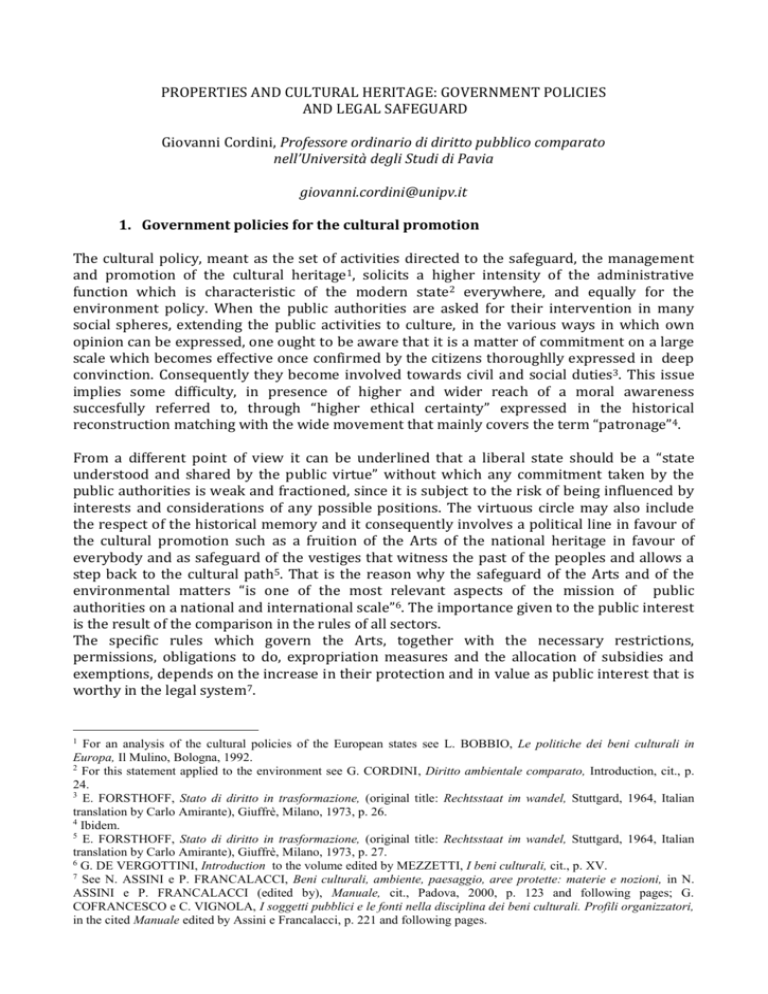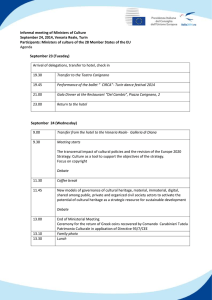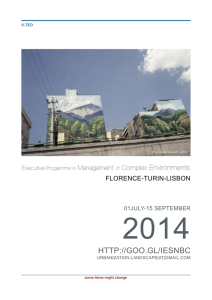THE ARTS AND THE CULTURAL HERITAGE: GOVERNMENT
advertisement

PROPERTIES AND CULTURAL HERITAGE: GOVERNMENT POLICIES AND LEGAL SAFEGUARD Giovanni Cordini, Professore ordinario di diritto pubblico comparato nell’Università degli Studi di Pavia giovanni.cordini@unipv.it 1. Government policies for the cultural promotion The cultural policy, meant as the set of activities directed to the safeguard, the management and promotion of the cultural heritage1, solicits a higher intensity of the administrative function which is characteristic of the modern state2 everywhere, and equally for the environment policy. When the public authorities are asked for their intervention in many social spheres, extending the public activities to culture, in the various ways in which own opinion can be expressed, one ought to be aware that it is a matter of commitment on a large scale which becomes effective once confirmed by the citizens thoroughlly expressed in deep convinction. Consequently they become involved towards civil and social duties3. This issue implies some difficulty, in presence of higher and wider reach of a moral awareness succesfully referred to, through “higher ethical certainty” expressed in the historical reconstruction matching with the wide movement that mainly covers the term “patronage”4. From a different point of view it can be underlined that a liberal state should be a “state understood and shared by the public virtue” without which any commitment taken by the public authorities is weak and fractioned, since it is subject to the risk of being influenced by interests and considerations of any possible positions. The virtuous circle may also include the respect of the historical memory and it consequently involves a political line in favour of the cultural promotion such as a fruition of the Arts of the national heritage in favour of everybody and as safeguard of the vestiges that witness the past of the peoples and allows a step back to the cultural path5. That is the reason why the safeguard of the Arts and of the environmental matters “is one of the most relevant aspects of the mission of public authorities on a national and international scale”6. The importance given to the public interest is the result of the comparison in the rules of all sectors. The specific rules which govern the Arts, together with the necessary restrictions, permissions, obligations to do, expropriation measures and the allocation of subsidies and exemptions, depends on the increase in their protection and in value as public interest that is worthy in the legal system7. 1 For an analysis of the cultural policies of the European states see L. BOBBIO, Le politiche dei beni culturali in Europa, Il Mulino, Bologna, 1992. 2 For this statement applied to the environment see G. CORDINI, Diritto ambientale comparato, Introduction, cit., p. 24. 3 E. FORSTHOFF, Stato di diritto in trasformazione, (original title: Rechtsstaat im wandel, Stuttgard, 1964, Italian translation by Carlo Amirante), Giuffrè, Milano, 1973, p. 26. 4 Ibidem. 5 E. FORSTHOFF, Stato di diritto in trasformazione, (original title: Rechtsstaat im wandel, Stuttgard, 1964, Italian translation by Carlo Amirante), Giuffrè, Milano, 1973, p. 27. 6 G. DE VERGOTTINI, Introduction to the volume edited by MEZZETTI, I beni culturali, cit., p. XV. 7 See N. ASSINI e P. FRANCALACCI, Beni culturali, ambiente, paesaggio, aree protette: materie e nozioni, in N. ASSINI e P. FRANCALACCI (edited by), Manuale, cit., Padova, 2000, p. 123 and following pages; G. COFRANCESCO e C. VIGNOLA, I soggetti pubblici e le fonti nella disciplina dei beni culturali. Profili organizzatori, in the cited Manuale edited by Assini e Francalacci, p. 221 and following pages. 2. The cultural heritage, the Arts, the environment and the cultural landscape: notions and distinctions On the assumption that it is impossible to separate the cultural items belonging to the historical and artistic heritage of a nation from their “overall environmental context” (archaeological areas, villages, towns, monumental complexes)8, while otherwise most urban and artificial landscapes belong to the category of environmental items which are the fruit of the human creativity. So the widest notion is the one of “environment”, since the term includes the cultural heritage, naturalistic elements and the changes due to the human behaviour, with reference to the relation aspects involved. As a matter of fact the term “environment” can be meant in a broad and general sense referring to the entire entity of the environmental issues which worry all the contemporary societies. The “cultural heritage” may also be a broad defintion, since therein included are all the elements concerning “culture”, as well as “individual and collective goods” (landscapes, areas, complexes) representing the artistic, architectonic, archaelogical heritage of a community. The environment rules concern the need for the safeguard of the natural environment and of the urbanized territory, the measures for the protection from pollution and the safeguard of the cultural heritage. In general the legislation of principles indicates common aims in the safeguard and promotion of all these elements. Several constitutional texts, community policies in the environmental field, resolutions of international conventions adopt a common line in the configuration of “the protected goods”. The other reasons that justify this common approach have a functional nature and concern the management of the cultural heritage and consequently cooperation and coordination between public and private subjects are imposed. On the other hand several specific juridical rules that characterize the Arts and the environmental goods are applied. Sector legislations require specific provisions for the separate safeguard of the Arts and of the environmental goods and the competence is often assigned to separate government ministries and bodies. In addition to that there are substantial differences which are classified by the legislator in a different way. The protection of the cultural heritage, as a matter of fact, binds authorities and private citizens to the accomplishment of duties and to the respect of specific obligations: in particular as far as the Arts are concerned there may be conservation duties, classification obligations, limits in their use, bans on exports9, while for the Arts the ordinary legislation provides for planning restrictions, safeguard measures, activity restraints. Needs for coordination are generally found in the regulations concerning the management of the Arts and the environmental goods. Consequently the doctrine tends to outline a common system, even if suggests separate definitions for the two categories, that is to say the Arts and environmental goods 10. In the course of the XVII session of the Unesco’s World Heritage Committee (Paris, July 1994) the definition of “cultural landscapes” in order to refer to goods which may mean the adoption 8 See G. DE VERGOTTINI, Introduction, cit., p. XV. Vergottini has precisely noticed that the protection of an area goes beyond the limits of the one of territories and of the environment so the close "permeation between an integrated and organic complex of relevant constitutional values to be protected” is evident. 9 The circulation of the Arts has beeb one of the most relevant problems on the juridical level. For an analysis of the matter in the Italian legal system you may see C. FABBRICATORE e A. SCARPA, La circolazione dei beni culturali, Giuffrè, Milano, 1998. 10 See C. MALINCONICO, I beni ambientali, CEDAM, Padova, 1991; S. AMOROSINO, Beni ambientali, culturali e territoriali, CEDAM, Padova, 1995; T. ALIBRANDI e P. FERRI, I beni culturali e ambientali, Giuffrè Milano, 1995; G. ROLLA, recently cited work, p. 225 and following pages. of “combined works of nature and man”11. These goods represent a new typology to be included in the list of the World Heritage. Three categories of cultural landscapes were specified: a) the landscape which is clearly defined, conceived and created by the man, like gardens and parks created for esthetic reasons; b) the “evolutionary landscape” which reaches its current form in association with and in response to the natural environment, like fossil landscapes and living landscapes which still play an active role in contemporary societies; c) “the associative cultural landscape” which is characterized by the aggregation force of the religious, artistic or cultural phenomena of the natural environment. 3. The classification of goods and their specific juridical regime The substantial uniformity of the constitutional principles concerning the safeguard and enhancement of the Arts, undoubtedly had an impact on the special juridical regime that nearly all the states have adopted for the safeguard and promotion of their cultural heritage. In the present synthesis I mean to point out the elements that show a clear similarity of patterns, even if the application and the effects are different one from the others. Then I will underline those peculiar differences which characterize certain legal systems in order to compare the different juridical experiences taken into consideration. The cultural heritage is almost always subject to special control. The juridical regime varies according to the goods and interests ruled out12. As regards the object taken into account by the regulation, the several cultural events, monuments, historic centres, archaeology, museums, libraries, archives, the landscape, natural beauties, the areas subject to special conservation obligations may be mentioned as examples. As for the classification of the interventions such as maintenance, different forms of restoration, modifications and transformations of the sites may be used as examples. The authorizations are graded according to the strength of the burden. The common ground that characterizes the status of the protected heritage is the conformity with the public interest. For instance in France they distinguish between “classified” goods on the basis of public interest in their conservation and “registered” goods for their “historic and artistic” value. The classification usually makes the obligation stronger and imposes the request of a permission for each restoration, while the registration implies a protection of the goods which is linked to more localized restrictions. In Italy the relevant act dictates regulations related to the typolgy of goods which are the object of the special control (from article 1 to 4) and rules for the acknowledgment of the goods which are subject to safeguard (from article 5 to 9)13. In Spain, the Ley de Patrimonio Histórico Español of 1985, collects all the goods (real estate and personal belongings) of artistic, historic, palaentological, archaeological, ethnographic, scientific and technical interests in the 11 See P. DE STEFANO e F. LUCARELLI (edited by), Il centro storico di Napoli. La lista del patrimonio mondiale Unesco, Studio Idea, Napoli, 1996, p. 13 and following pages. 12 A specific regime may be applied to some ecclesiastic or religious interest goods. In Italy the difference between “the ecclesiastic heritage” towards which the state has always a right of intervention, and specific goods “religious interest goods” that the regime based on concordats assigns to the competence of the ecclesiastic authority and subjects to a specific discipline. See P. A. D’AVACK, Patrimonio culturale ecclesiastico, voce dell’Enciclopedia del Diritto, XXXII, Milano, 1982, p. 420 and following pages.; L. MUSSELLI, Beni culturali nel diritto canonico, item Digesto delle discipline 13 For specific comments on the relevant act adopted through the decree D. Lgs. 29 ottobre 1999, n. 490 you may see: G. CAIA (edited by), Il testo unico sui beni culturali e ambientali, cit., Milano, 2000; A. PAPA, M. BIGNAMI, C. CEPELLI, V. FIDANI, C. LINZOLA, L. PONIZ e G. RUGGERI, Testo unico sui beni culturali, Giuffrè, Milano, 2000; R. TAMIOZZO, La legislazione dei beni culturali e ambientali, Giuffrè, Milano, 2000; N. ASSINI e G. CORDINI, Manuale dei beni culturali, Padova, 2006 same term “goods of cultural interest”14. The degree of safeguard and the juridical regime varies according to the classification of the goods: a) with the acknowledgment of its cultural interest (through a real decree of the “Council of Ministers”); b) with the registration in the general heritage inventory; c) with the acknowledgment of protected area by the town main plan. Most maintenance and restoration interventions may be authorized locally and/or within the region. The cultural interest provided for by the Spanish law is similar to the recognition of the public interest that is found in the legislation of other states. In the United Kingdom there are classified goods (listed buildings), especially historic buildings, on which an authorization regime (with obligations graded according to the value and the characteristics of the goods concerned) and light forms of control regarding specific “areas of conservation” are imposed. In Germany in conformity with the doctrine the public interest to the conservation of the cultural heritage, even if it is necessary for the configuration of the special juridical regime concerning the Arts consists of an “undetermined juridical concept”15. The juridical regime of the single goods is defined according to technical, historic, town plans and artistic criteria which are justified in the sector regulations and always allow the authorities in charge of the goods management to exercise, a sort of discretionary power to be meant as a freedom of choice of the criteria and of the trusted means, in addition to the binding characteristic of the target, following the traditional doctrine. 14 See C. BARRERO RODRIGUEZ, La ordenacion juridica del Patrimonio Historico, Madrid, 1990; M. ALEGRE AVILA, Evolucion y regimen juridico del Patrimonio Historico, Madrid, 1995. Professor Ruiz-Rico Ruiz stated that the expression “cultural interest goods” is the one which best applies to the recent doctrinal constructions, while the notion of “historic and artistic heritage” is included in the Spanish legislative tradition. See G RUIZ-RICO RUIZ, Il regime costituzionale e legislativo del patrimonio storico, artistico e culturale spagnolo, in L. MEZZETTI (a cura di), Cited work, p. 283 15 See J. LUTHER, Il diritto dei beni culturali nella Repubblica federale di Germania, in L. MEZZETTI, (edited by), I beni culturali, cit., p. 225.

